Facility Design
Maximize longevity and minimize the risk of piping system failure
How To Select Proper Expansion Joints for Mission Critical Applications
Two types of expansion joints can be found in mission critical applications: rubber and stainless steel. In general, expansion joints can be used in piping systems to provide stress relief, flexibility, movement in all directions, vibration control, and sound dampening. Expansion joints are commonly found on the suction and discharge side of pumps, at tank connections, in the middle of pipe runs to assist with thermal movement, and near building separations for seismic activity. Regarding mission critical applications specifically, rubber expansion joints are used in mechanical rooms mated to pumps and tanks, and stainless steel expansion joints are used in long runs of pipe to assist with thermal and seismic movement.
In general, the average life span of rubber expansion joints for most applications is seven to 10 years, while the life span of stainless-steel expansion joints is longer. Even with such long life spans, it's recommended by most manufacturers that consistent inspection, every six months to one year, be conducted on all expansion joints to ensure they are in proper working condition. Many manufacturers offer on-site support in the form of expansion joint surveys.
Rubber Expansion Joints
Before discussing the styles of expansion joints found in piping systems for mission critical applications, it’s important to understand the benefits of using rubber expansion joints at pump connections. When a pump is turned on or off too quickly (or if a valve is opened or closed in the same manner), a surge force will occur in the piping system. Without the use of an expansion joint, this surge force will wreak havoc on the mechanical equipment. Therefore, the expansion joint can be used as a “shock absorber” to prevent damage. Similarly, during operation, a pump is vibrating and shaking. This movement can cause the mechanical seals and bearings inside the pump to wear out. Installing rubber expansion joints will increase the longevity of the pump. It is more cost-effective to replace two expansion joints than it is to repair or replace just one pump.
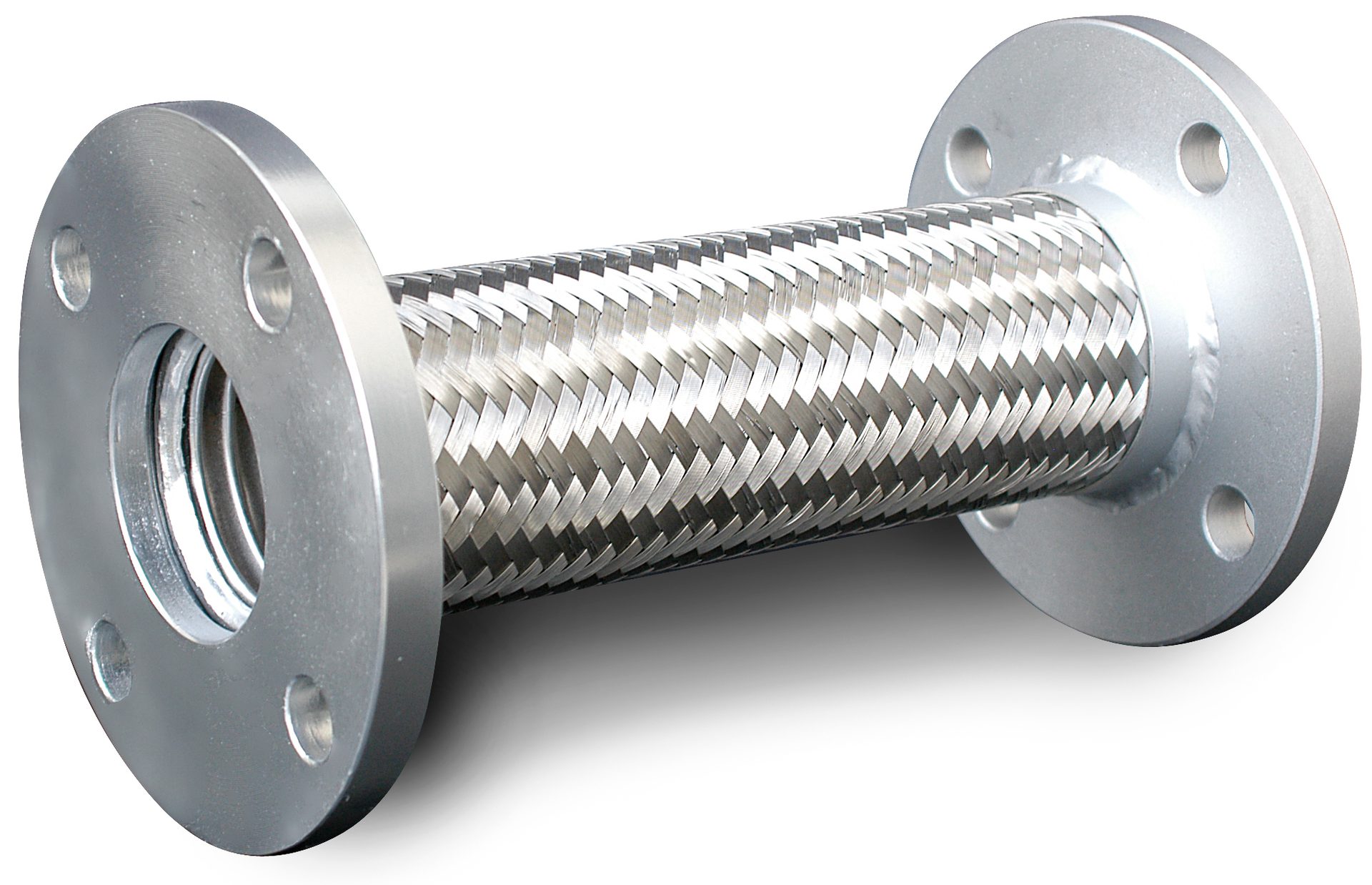
Stainless steel hose with braided, flexible connector.
Images courtesy of Proco Products Inc.
The most common rubber expansion joint is the molded wide arch. This type of design allows for a low-spring rate, which is best for plastic piping applications. Low spring rate is defined as the amount of force required to compress or extend the expansion joint 1 inch and return back to its neutral state. An expansion joint with a standard spring rate will work fine for carbon steel or ductile iron piping systems; however, there is a possibility the stiffness may cause the mating flange of the plastic piping system to crack, which would then result in a catastrophic failure. Therefore, it is industry standard to use low-spring-rate expansion joints for all plastic piping systems. Low-spring-rate expansion joints come in a variety of elastomers. They can also be provided with a single or double arch. The double arch will allow for higher movement capabilities with a longer overall length.
Another important rubber expansion joint to mention is reducing concentric and eccentric. This type of expansion joint is used when the mating flanges of mechanical equipment and piping system vary in size. Installing this product eliminates the need for a reducing spool piece. It's important to note the eccentric reducer must always be on the suction side of the pump, and the concentric reducer must always be on the discharge side of the pump. The tapered side of the eccentric reducer must face downward should the expansion joint be installed in the horizontal position.
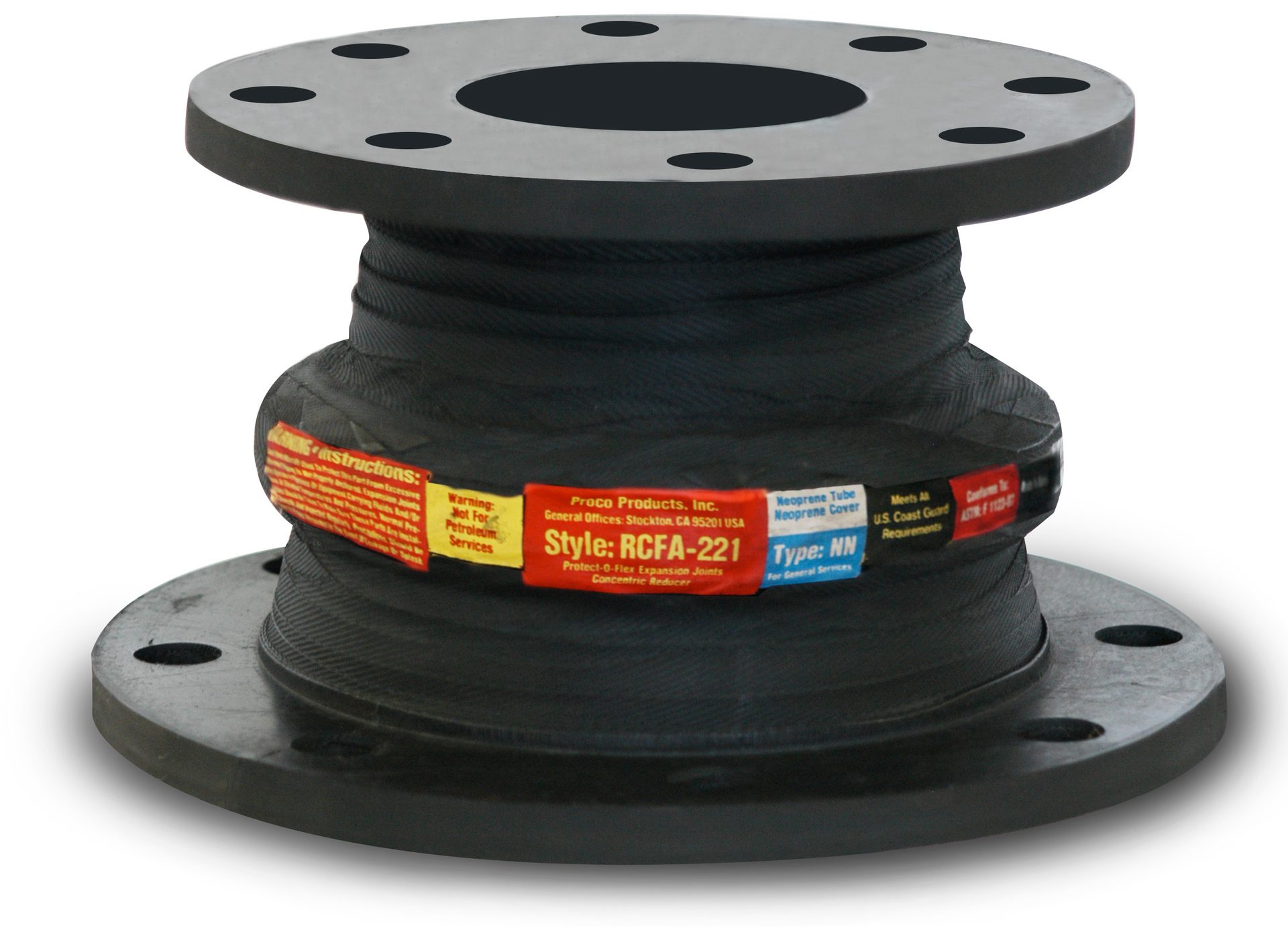
A reducing concentric rubber expansion joint.
Stainless Steel Expansion Joints
The two most common types of stainless steel expansion joints used in mission critical applications are the V- and U-loop. Both are types of low-spring-rate expansion joints; however, the geometry is a bit different. The V-loop will have a longer face-to-face dimension but a shorter depth. A U-loop will have a smaller face-to-face dimension and a longer depth. In general, the V-loop is more common because it can easily be nested. Should multiple pipes run parallel to one another in a hallway, for example, the V-loop can be provided via standard construction and will nest appropriately with less of a footprint than nested U-loops.
As mentioned earlier, a low-spring-rate expansion joint works best in plastic piping applications due to the minimal force exerted on the mating flanges. This makes the loop an ideal choice in long runs of pipe to absorb thermal movement. The amount of movement in a plastic piping system is determined by the length of pipe as well as the maximum temperature variance, or delta T (ΔT). A standard loop is rated for plus or minus 4 inches of movement. If the ΔT of the piping system is a large value, or if the piping system is many hundreds of feet long, the live length of the hose can be adjusted in the V-loop to compensate for the movement requirements. Increasing the live length of the hose will change the geometry of the loop, but it may provide a more cost-effective option, reducing the number of loops required for one straight run of pipe.
It is also important to note that V- or U-loops can also be used near building separations in mission critical facilities that need to account for seismic movement. The legs of the loop can move in the X, Y, and Z planes.
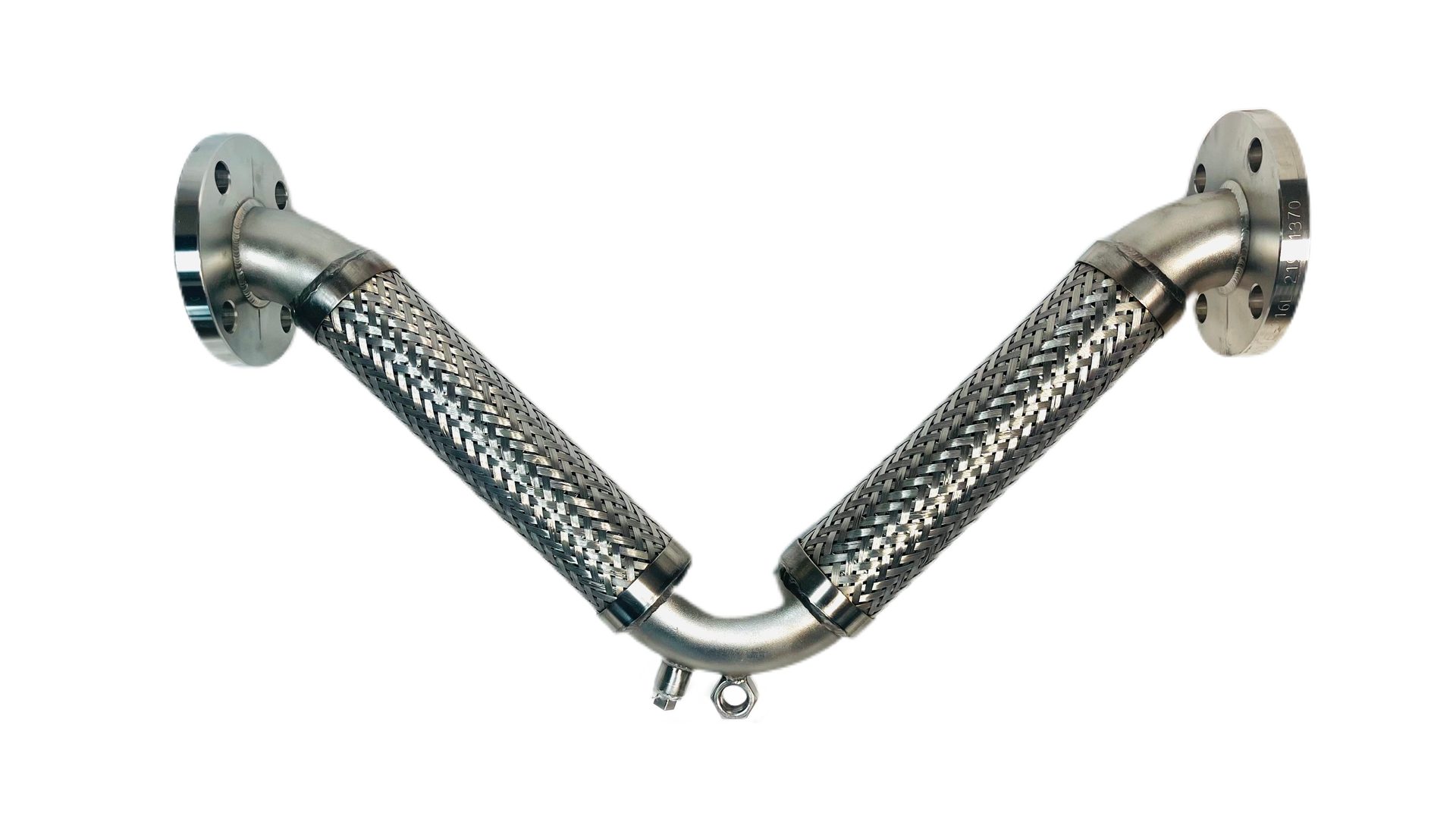
A V-loop expansion joint.
A Common Misconception
Expansion joints can be classified as pump connectors, but not all pump connectors can be classified as expansion joints. Take, for instance, the stainless steel hose and braid flexible connector. Many people refer to them as expansion joints, but, unfortunately, they are not. A stainless steel, braided connector can only assist with lateral movement or movement in one direction. The interwoven braid prevents the expansion joint from providing extension capabilities. It acts as an elongation control mechanism. In addition, the braid is what provides the inner hose its strength. For example, a 6-inch stainless steel hose without braid only offers a psi rating of 5. Once a layer of braid is added, the pressure rating increases to 165 psi, a 3,300% difference. For this reason, it's also recommended that hose and braid pump connectors not be used to compensate for axial compression. Should this happen, the braid will no longer support the pressure rating of the inner hose, and a catastrophic failure is likely.
There is a time and a place for everything, though, so it’s important to understand when it is appropriate to use an expansion joint versus a braided connector.
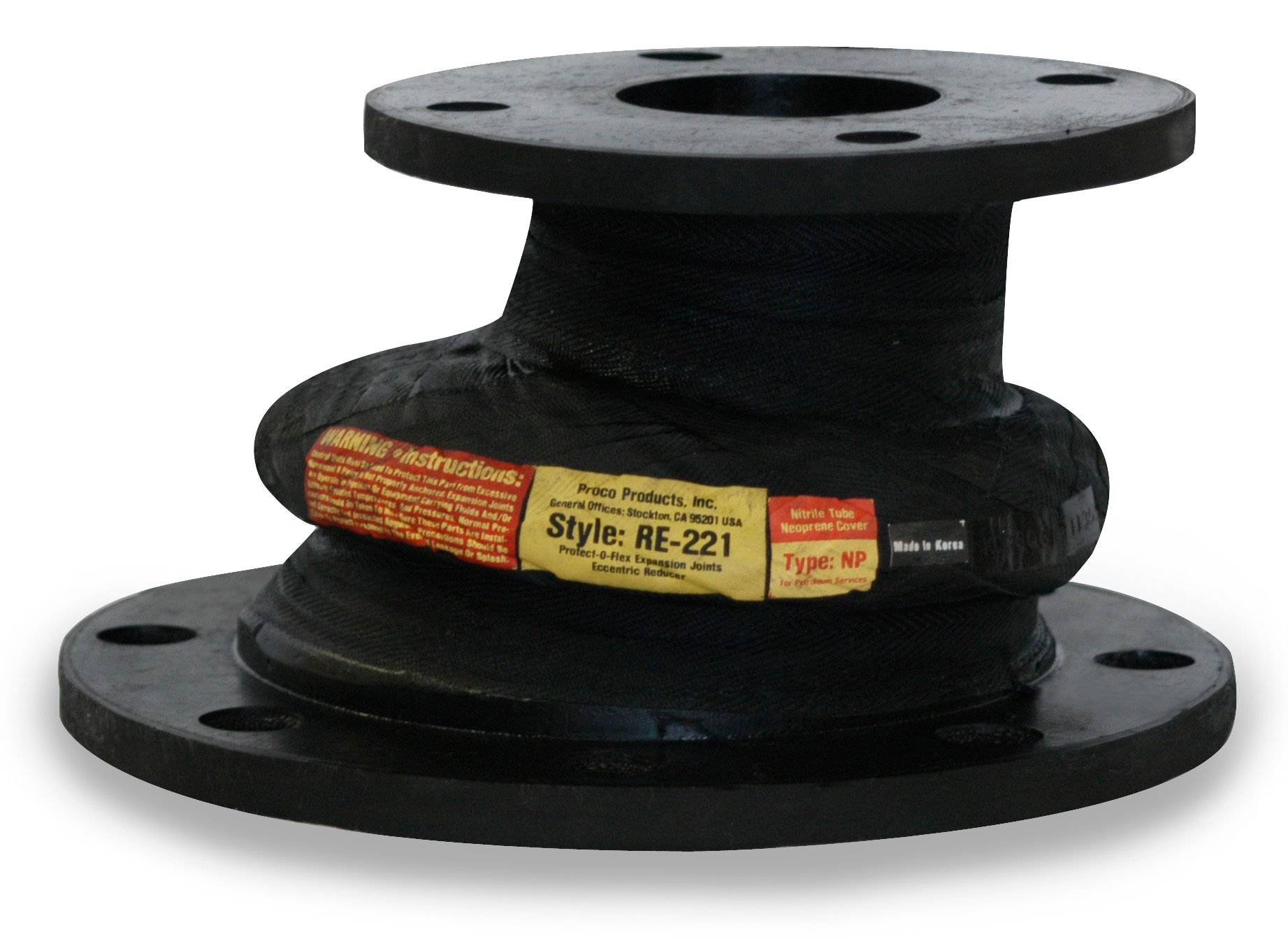
A reducing concentric rubber expansion joint.
Additional Information
- The acronym STAMPED (size, temperature, application, movement, pressure, end fittings, delivery) can also be used to determine the best expansion joint for the given application. Once this information is obtained, an expansion joint manufacturer can assist with selection.
- Many engineers are working with programs like CAE-Pipe and Caesar II, which allow pipe stress engineers to analyze stress points in a piping system and the benefits that will occur once an expansion joint is introduced. Please consult an expansion joint manufacturer that can provide you with CAD, BIM, or Revit drawings.
- Some manufacturers take part in Expansion Joint Manufacturers Association (EJMA) as well as Fluid Sealing Association (FSA). Companies that adhere to the quality of manufacturing standards set forth by both associations are recommended.
- Control rods may be utilized to prevent over-compression or over-extension of a rubber expansion joint. The natural reaction of a piping system is to expand outward when pressure is introduced. Control rods in this situation will prevent the expansion joint from over-extending past its rated movement. There are some situations where control rods can be used to prevent over-compression as well. Rubber expansion joints can be installed vertically in a piping system. If the weight of the pipe is unproperly supported, or if a large valve sits on top of the rubber expansion joint, this may result in the expansion joint “popping.”
- An expansion joint has both a maximum pressure and temperature rating. For example, a molded wide arch in EPDM has a rating of 225 psi at 250°F. Changing the elastomer to neoprene will provide 225 psi at 225°. In both instances, the expansion joint can not operate at both its maximum pressure and temperature simultaneously. Using the EPDM values for this example, at 220° the expansion joint will have a derating factor of roughly 0.71 for the pressure. This signifies that the expansion joint can function properly at 160 psi at 220°. The same relationship occurs when the pressure rating is increased. The temperature rating will be lowered.
- Depending on the piping system, pipe guides and anchors may also be used. Anchors are located at the end of pipe runs. The objective is having the movement of the pipe directed inward to be absorbed by the expansion joint. The pipe will either expand or contract depending on hot or cold media respectively. Additionally, pipe guides can be used to assist or guide the pipe into the pipe anchors. For more information about guides and anchors, please refer to EJMA.
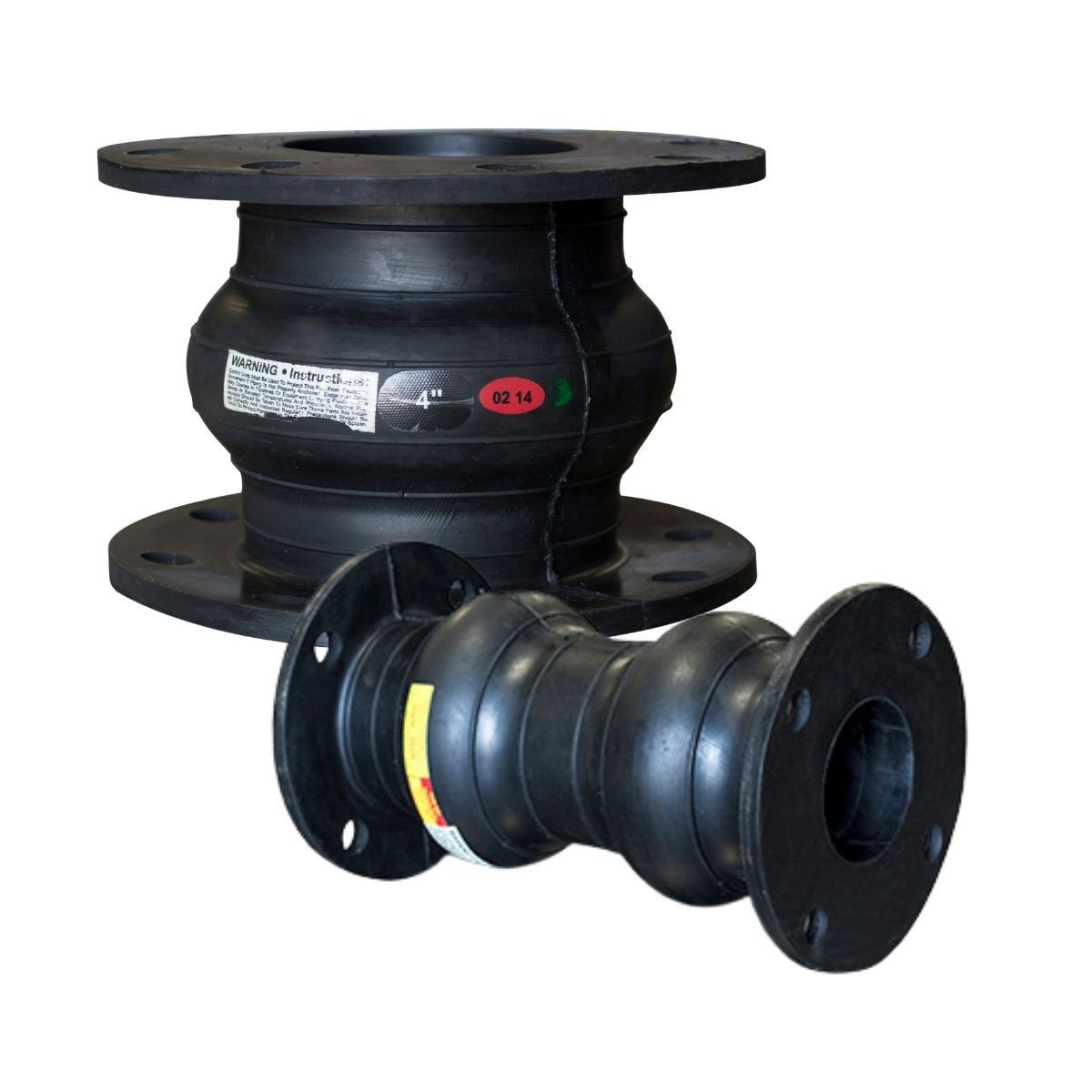
Low spring rate rubber expansion joints.
Conclusion
Rubber and stainless steel expansion joints are required for mission critical applications, and proper selection is of the utmost importance. This article will serve as a preliminary guide to ensure maximum piping system efficiency, longevity, and minimization of failure risk.
Eric Blazej
Eric Blazej is the national industrial distribution sales manager for Proco Products Inc. He has 12 years of experience in expansion joint sales. Blazej spent eight years of his career on the HVAC and plumbing side and has since been focused on industrial applications, working with engineers, distributors, contractors, OEMs, and end users on proper selection.
Image by Peter H from Pixabay

